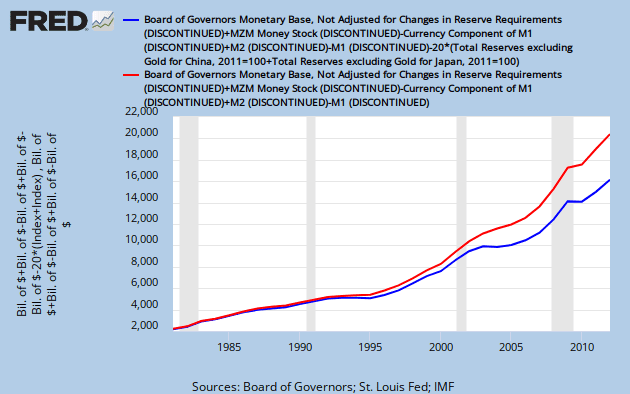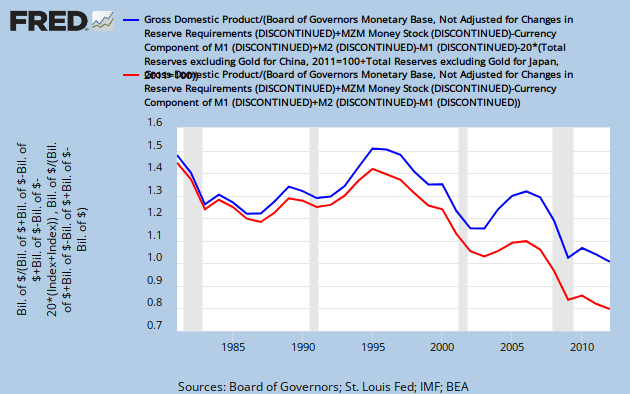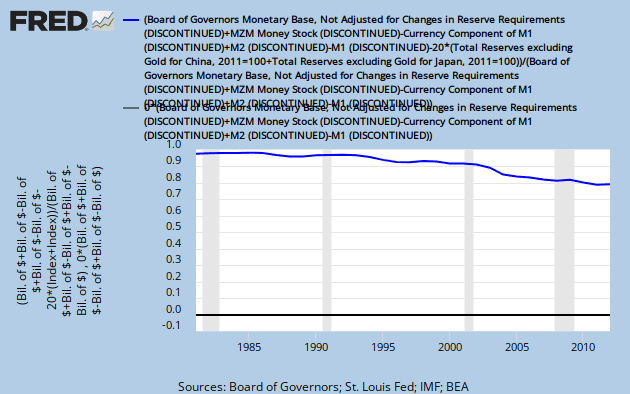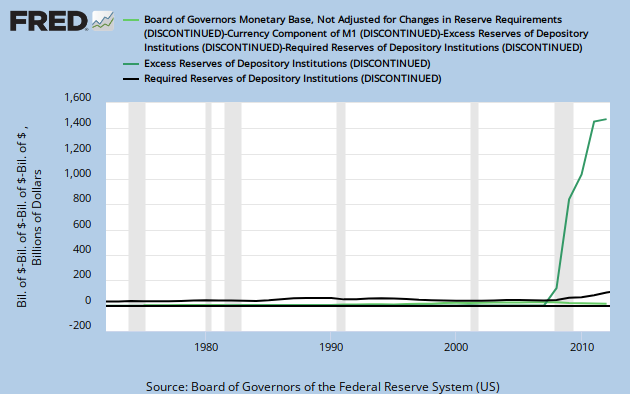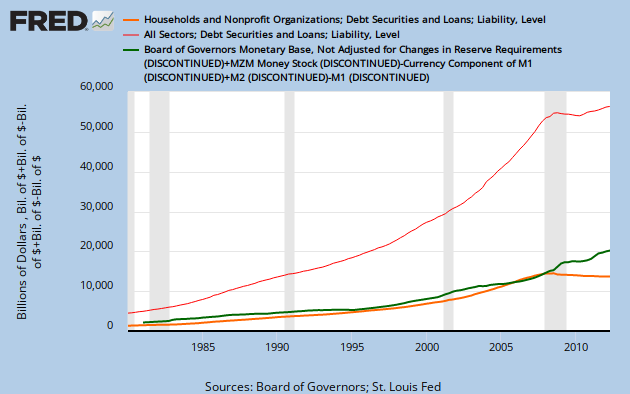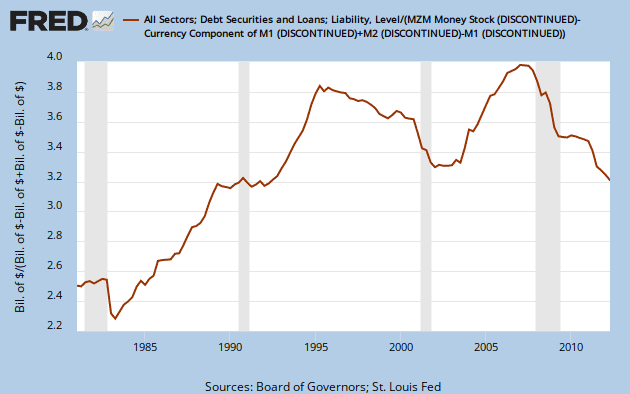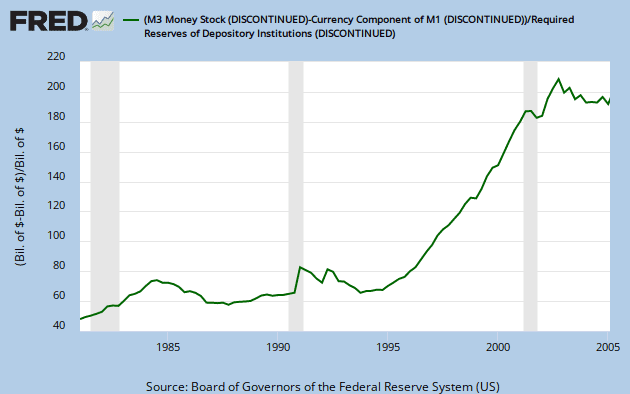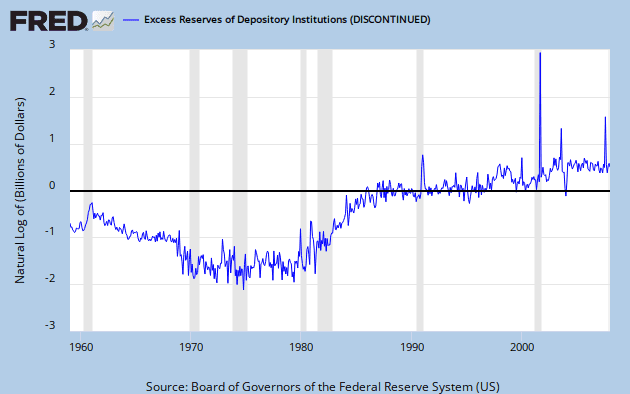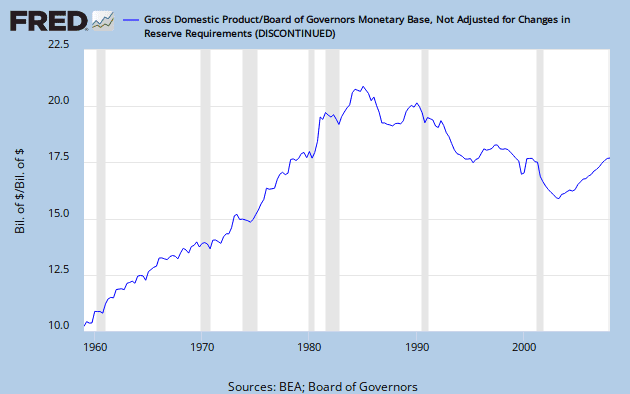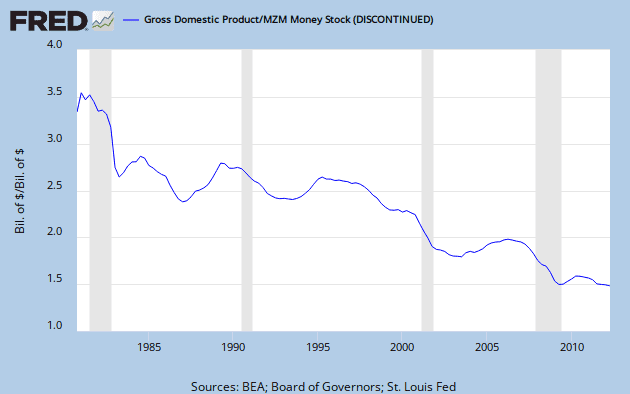Widdekind
Member
- Mar 26, 2012
- 813
- 35
- 16
currency in banks ?
Prima facie, bank-vaults were "cleaned out" in
required Reserves ?
From the Vietnam War to 9/11, required Reserves decreased steadily, from 40% to 5%, then increased suddenly by 13x (to two-thirds), after c.2008.
currency in circulation ?
From the Vietnam War to 2008, the fraction of currency in circulation steadily increased by half, from 60-90%, then suddenly decreased to one-third. Prima facie, since 2008, "everybody (including foreign holders ?) parked their money in banks". Indeed, since 2008, the Velocity of the (total) Money-Base (VB = GDP / MB [#/quarter]) has decreased by 3x (from 18 to 6 [transactions/quarter]):
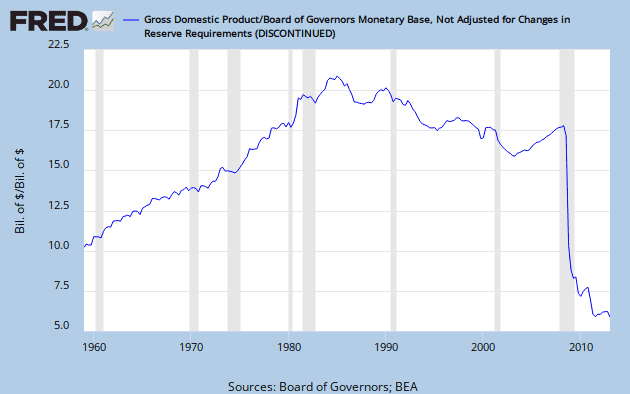 The impact, of 2008, on the Velocity of (active) Currency, was less pronounced, decreasing by one-sixth (from 18 to 15 [transactions/quarter]):
The impact, of 2008, on the Velocity of (active) Currency, was less pronounced, decreasing by one-sixth (from 18 to 15 [transactions/quarter]):
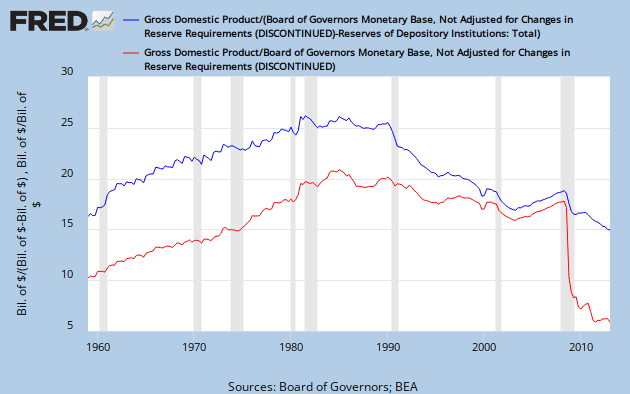 Growing convergence, of VC & VB, reflected de-Savings.
Growing convergence, of VC & VB, reflected de-Savings.
2000 Savings spree ?
Prima facie, c.2000, a sudden "spree" of Savings doubled the amount of (non-Reserve) Currency "on hand" in banks (i.e. "in cash registers behind counters"), from 3.5% to 7% of total Money Base. The "spree", perhaps associated with the tense 2000 Presidential election, ended as suddenly as it began.
Fed hoarding excess Reserves ?
before 2008, the Federal Reserve system held negligible excess-Reserves; after 2008, excess-Reserves increased allot, accounting for nearly all of the (above trend) increase in Money-Base:
miscellaneous notes (for future reference)
when utilizing the "FRED" online financial data grapher,
according to Wikipedia
M3 "bond" component sky-rocketed after 1993 NAFTA ratified; M3 is no longer reported, perhaps because China holds all of the (tacitly implied) long-term debt (>$3T) ?
de facto Reserve ratio has decreased, from ~2% under Reagan, to ~1% under Clinton, to <1% under Obama:
components of "pseudo-Money"
in big round numbers, by 2005, total "pseudo-Money" was ~$12T:
over-simplistically, private individuals Save into banks (savings Deposits & MMAs), then banks Invest into businesses & Governments (bonds & MMFs), with some "spill over" if-and-when Invested Money buys securities from private individuals. By such "Money flows", private individuals' Savings is re-loaned, as Investments, back out to
estimating "pseudo-Money" ?
using "savings Deposits" as a proxy for "bonds", we can construct a proxy for "pseudo-Money":
in big round numbers, the top two curves (pseudo-Money vs. estimate) correlate closely.
also in big round numbers, total non-savings Deposits of private individuals approximates total investments into Money-Market Funds:
i.e. "banks use your 'checking accounts' & 'money-market accounts' to Invest in MMFs (which Invest in short-term Government & business bonds)"; banks offer MMAs "to compete against MMFs".
MB = [currency in circulation] + [currency in bank-vaults] + [Reserves in banks]
= M0 + Mv + R
Mv = MB - M0 - R
%Mv = Mv / MB = 1 - [M0 + R]/MB
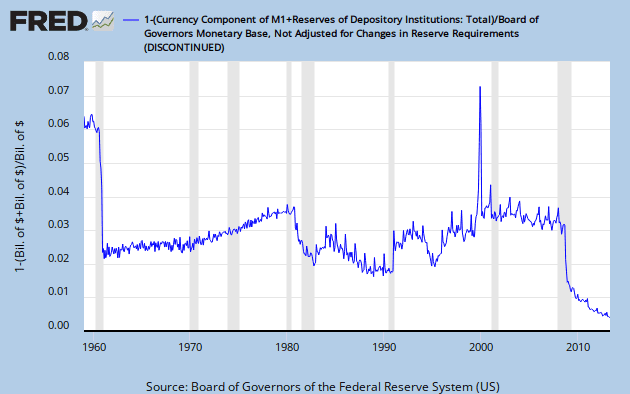
= M0 + Mv + R
Mv = MB - M0 - R
%Mv = Mv / MB = 1 - [M0 + R]/MB

Prima facie, bank-vaults were "cleaned out" in
- 1960 (JFK elected)
- 1980 (Reagan elected)
- 2008 (Obama elected)
required Reserves ?
R/MB
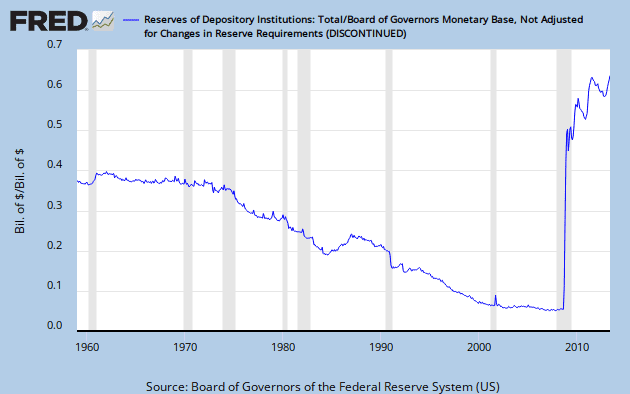

From the Vietnam War to 9/11, required Reserves decreased steadily, from 40% to 5%, then increased suddenly by 13x (to two-thirds), after c.2008.
currency in circulation ?
M0/MB
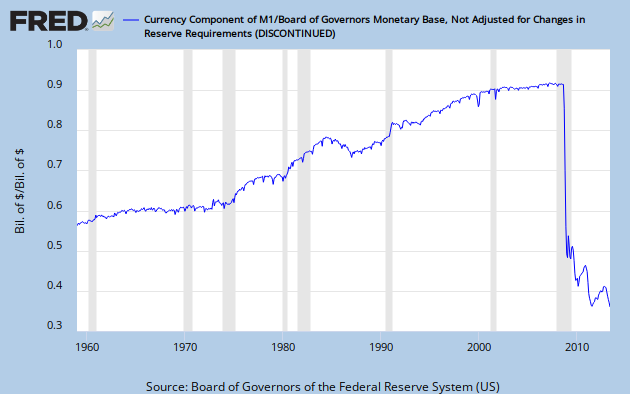

From the Vietnam War to 2008, the fraction of currency in circulation steadily increased by half, from 60-90%, then suddenly decreased to one-third. Prima facie, since 2008, "everybody (including foreign holders ?) parked their money in banks". Indeed, since 2008, the Velocity of the (total) Money-Base (VB = GDP / MB [#/quarter]) has decreased by 3x (from 18 to 6 [transactions/quarter]):

[currency] = [currency in circulation] + [currency in bank-vaults]
MC = MB - R
VC = GDP / MC
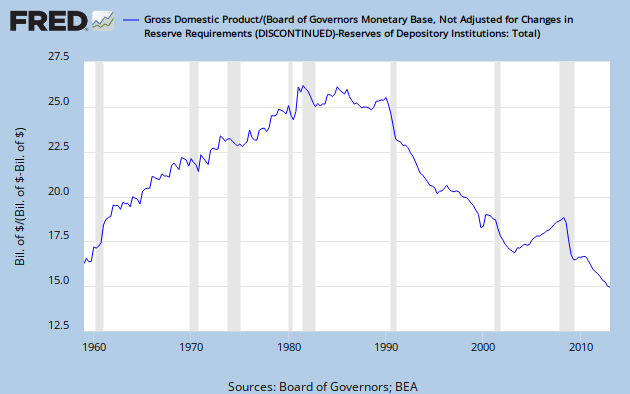
Ipso facto, USD still in circulation are "moving" almost as fast as they were before 2008; but, large amounts of USD were de-circulated into "frozen" Reserves. Plotting both (VC > VB) together:MC = MB - R
VC = GDP / MC


2000 Savings spree ?
Prima facie, c.2000, a sudden "spree" of Savings doubled the amount of (non-Reserve) Currency "on hand" in banks (i.e. "in cash registers behind counters"), from 3.5% to 7% of total Money Base. The "spree", perhaps associated with the tense 2000 Presidential election, ended as suddenly as it began.
Fed hoarding excess Reserves ?
before 2008, the Federal Reserve system held negligible excess-Reserves; after 2008, excess-Reserves increased allot, accounting for nearly all of the (above trend) increase in Money-Base:
required Reserves, total Reserves, MB, MB - excess Reserves = MB - (total Reserves - required Reserves)
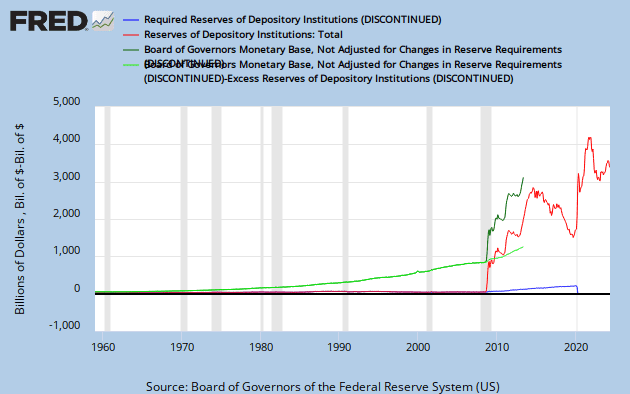
Ignoring excess-Reserves, in Federal Reserve bank "hoards":
M0* = [currency in circulation] + [currency in bank-vaults] ("circulating currency")
= MB - [total Reserves]
MB* = M0* + [required Reserves] ("active currency")
= MB - [excess Reserves]
V0* = GDP / M0* ("circulating currency velocity")
VB* = GDP / VB* ("active currency velocity")
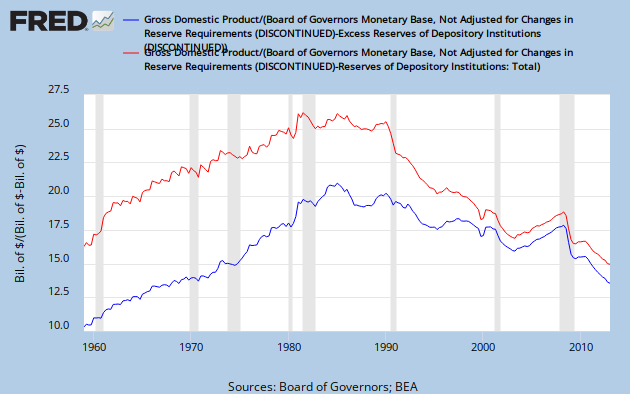
Money Velocities of ~15 per quarter equate to ~1 per business-week.= MB - [total Reserves]
MB* = M0* + [required Reserves] ("active currency")
= MB - [excess Reserves]
V0* = GDP / M0* ("circulating currency velocity")
VB* = GDP / VB* ("active currency velocity")

miscellaneous notes (for future reference)
when utilizing the "FRED" online financial data grapher,
[M1] - [Currency] = [demand Deposits] = "total checkable Deposits"
according to Wikipedia
[MZM] - [M1] - [savings Deposits] = "money-market funds"
[M2] - [M1] - [savings Deposits] = "money-market accounts"
[M3] - [M2] = "bonds"
{[M3] - [Currency]} +{[MZM] - [M1] - [savings Deposits]} = "checking + saving Deposits" + "bonds" + "money-market funds"
= "all extra-Currency pseudo-Monies"
MMFs, MMAs, Bonds, pseudo-Money
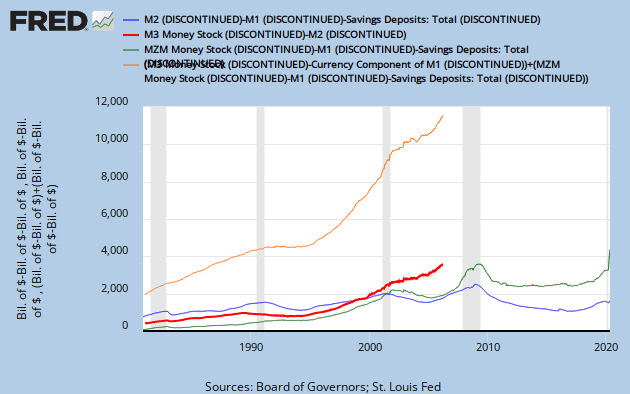
[M2] - [M1] - [savings Deposits] = "money-market accounts"
[M3] - [M2] = "bonds"
{[M3] - [Currency]} +{[MZM] - [M1] - [savings Deposits]} = "checking + saving Deposits" + "bonds" + "money-market funds"
= "all extra-Currency pseudo-Monies"
MMFs, MMAs, Bonds, pseudo-Money

M3 "bond" component sky-rocketed after 1993 NAFTA ratified; M3 is no longer reported, perhaps because China holds all of the (tacitly implied) long-term debt (>$3T) ?
de facto Reserve ratio has decreased, from ~2% under Reagan, to ~1% under Clinton, to <1% under Obama:
[pseudo-Money] / [required Reserves] = [de facto Reserve ratio]
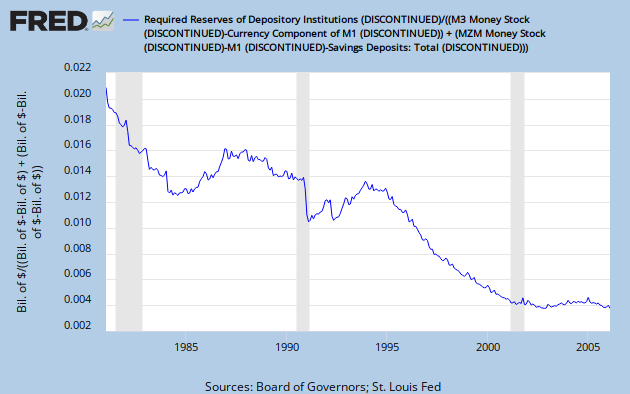
Federal Reserve requirements comprise
- no-reserve tranche of 0% (less than $12M)
- low-reserve tranche of 3% (less than $71M)
- high-reserve tranche of 10% (more than $71M)
components of "pseudo-Money"
in big round numbers, by 2005, total "pseudo-Money" was ~$12T:
- savings ~$4T
- MMAs ~$2T
- MMFs ~$2T
- bonds ~$4T
[pseudo-Money] = [checking + savings Deposits] + [money-market Deposits] + [money-market funds] + [bonds]
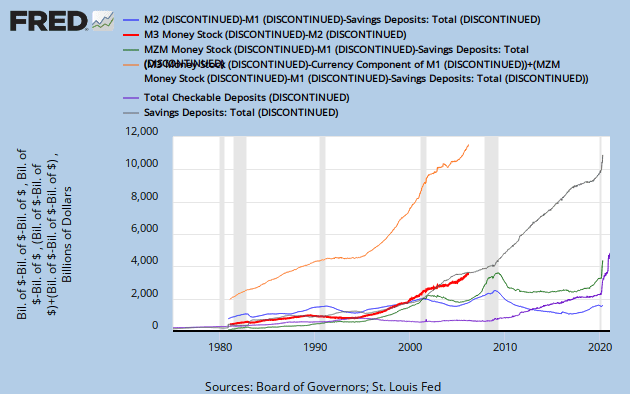

over-simplistically, private individuals Save into banks (savings Deposits & MMAs), then banks Invest into businesses & Governments (bonds & MMFs), with some "spill over" if-and-when Invested Money buys securities from private individuals. By such "Money flows", private individuals' Savings is re-loaned, as Investments, back out to
- private individuals for Consumption (C)
- businesses for Capital Investment (I)
- Governments (G)
estimating "pseudo-Money" ?
using "savings Deposits" as a proxy for "bonds", we can construct a proxy for "pseudo-Money":
[savings Deposits] ~= [M3] - [M2]
[pseudo-Money] = {[M3] - [Currency]} + {[MZM] - [M1] - [savings Deposits]}
~= {[M2] + [savings Deposits] - [Currency]} + {[MZM] - [M1] - [savings Deposits]}
= [MZM] - [Currency] + [M2] - [M1]
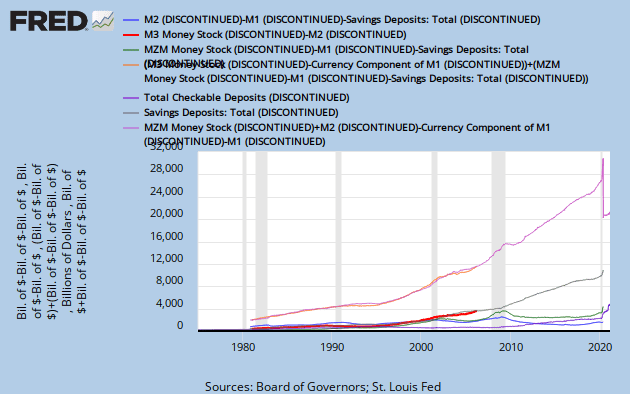
[pseudo-Money] = {[M3] - [Currency]} + {[MZM] - [M1] - [savings Deposits]}
~= {[M2] + [savings Deposits] - [Currency]} + {[MZM] - [M1] - [savings Deposits]}
= [MZM] - [Currency] + [M2] - [M1]

in big round numbers, the top two curves (pseudo-Money vs. estimate) correlate closely.
also in big round numbers, total non-savings Deposits of private individuals approximates total investments into Money-Market Funds:
[MMF] = [MZM] - [M1] - [Currency]
~= [checking Deposits] + [MMA]
= [M2] - [M1] - [savings Deposits] + [checking Deposits]
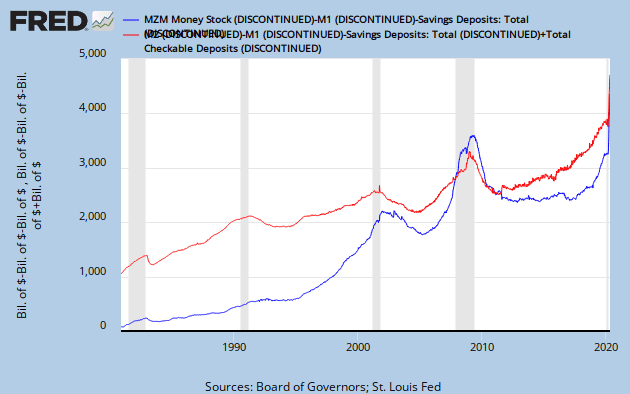
~= [checking Deposits] + [MMA]
= [M2] - [M1] - [savings Deposits] + [checking Deposits]

i.e. "banks use your 'checking accounts' & 'money-market accounts' to Invest in MMFs (which Invest in short-term Government & business bonds)"; banks offer MMAs "to compete against MMFs".
Last edited:

